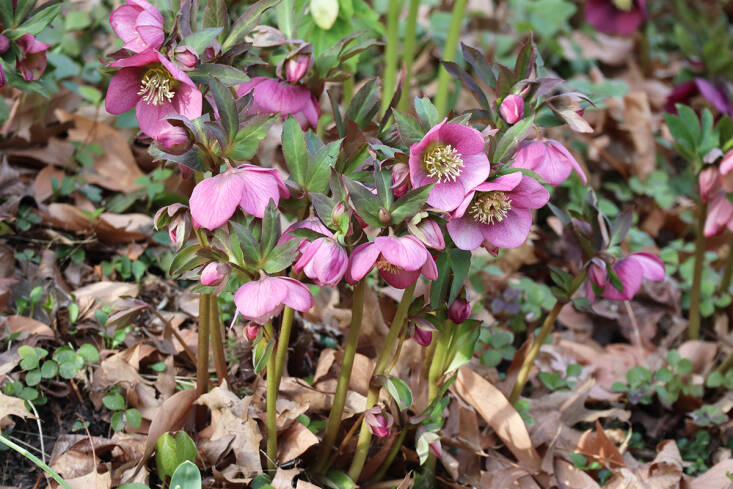That last stretch of winter can feel interminable. Spring is a month or more from being declared, the Vernal Equinox is a rumor. The season of buds and their beautiful effusion is in the offing, but it’s not here, yet. Darkest before the dawn? It really is. We need hope, with petals. This is the time when gardeners turn with renewed interest to the most prescient of flowering plants. They defy the season, blooming no matter what: Trees, shrubs, perennials, lawn weeds! Anything to show us that life persists, and will return.
From plants underfoot to the branches above, here are some of the most reliable harbingers of spring, the floral lights at the end of the tunnel.
Photography by Marie Viljoen.
Henbit

We begin with a lowly weed. But blessed is the lawn interwoven with the mat-forming sprawl of henbit, a member of the mint (Lamiaceae) family. Like its later, mid-spring flowering cousins, deadnettle and ground ivy, henbit’s vivid and long-throated flowers open early to feed bees and to brighten and diversify what is so often a barren monoculture of grass.
Butterbur

Butterburs (members of the genus Petasites) are aesthetically fascinating plants, whose otherworldly, tufted flowerheads materialize from barren soil months before their prehistoric-looking leaves spread out vastly in the shade. The plants are native to Central and East Asia, where they are valued as edible heralds of spring (the flowers and tender stems of the leaves must be cooked prior to eating).

While the non-native butterburs are outstanding plants for difficult areas like deep shade and poorly-drained soil, they are better suited to the confines of urban gardens than to more pristine or preserved country habitats, where their invasive tendencies can cause wider-reaching problems. There is a North American butterbur, though: wetland-loving Petasites frigidus (the species name says it all), but it is not easily to be found at nurseries. Any growers out there? There’s a niche.
Snowdrops

Snowdrops—Galanthus nivalis (whose species name—”of the snow”—speaks winter)—appear well before freezing temperatures are done with us. A dainty and gentle brush of springtime in winter, they thrive beneath deciduous trees, brightening the leaf litter and becoming dormant by summer.
Hellebores

Hellebores, or Lenten roses, require no introduction, but it is worth remembering that, with some grooming, they can be spectacular, versus disheveled: Trimming back any damaged or ragged foliage from the previous season allows their exquisite flowers to be seen (and photographed) to most flattering effect.

If you’re hoping to enjoy their Gothic colors indoors, you may be aware that they have a reputation for being fickle as cut flowers. But Michelle Slatalla’s 2020 experiment showed that, for the vase, purple and maroon flowers defy the Lenten rose curse. (Curiously, the pale shades give up the ghost.)

Daphne

Fickle to become established, once she’s happy, she’s happy. Semi-shade-tolerant Daphne’s fragrance is strong and the tubular flowers are framed by the shrub’s evergreen, sometimes variegated, foliage.
Edgeworthia

Edgeworthia chrysantha is fantastic in the original sense of the word. Starting in mid-winter, its silver-furred buds begin to form at the tips of the shrub’s bare branch, whose smooth form is incongruously reminiscent of heat-loving succulents. When the flowers open they are a rich yellow, which is concentrated towards the center of each down-turned cluster. They release an even richer fragrance while most of the world is still very cold and bare.
Winterhazel

But…which hazel is it? Terrible garden pun. Winter- and witch-hazels both belong to the family Hamamelidaceae. Neither of them is really a hazel. With the exception of native American, fall-blooming witch-hazels, both shrubs (or small trees) flower very early (the witch- preceding the winter-).
Winterhazel is Corylopsis, and has buttercup-yellow flowers, often in clusters, depending on the species. Its branches are tightly-knit or layered, giving it the sunny shrub an opulent, pre-spring coat of scented flowers. It blooms best in full sun.
Witch-Hazel


Witch-hazel’s electric, streamered petals ablaze against a backdrop of snow are unforgettable, and at their peak when backlit by a low winter sun. Up close, they are perfumed. On a still day that scent is discernible from a distance.
Dawn Viburnum

Speaking of scent: This early-blooming viburnum smells delicious. V. x bodnantense ‘Dawn’ (and V. farreri, an almost-identical shrub) produces winter buds that start off rosy, opening to either deep pink, pale pink, or near-white. (The bodnantense hybrid is a cross between V. farreri and V. grandiflorum). Like camellias in cold climates, this small tree is best planted with some protection from winter winds, which will burn and brown the early buds.
Pussy Willow

Smartly-placed in front an evergreen (or red-twig) backdrop, the silvery and silken catkins of pussy willow are shown to full effect, and they are always irresistible: Stroke their dainty toes. Salix discolor is a North American native that relishes water and is a good choice for pond edges and rain gardens. Cut branches early to bring indoors for forcing.

Spicebush

Spicebush—Lindera benzoin—is the earliest native shrub-slash-small-tree to bloom in deciduous forests. Its delicate yellow flowers form a pale halo over the trees while the surrounding woods are leafless and brown. Scratch a twig and sniff its deep, citrus-scent (and take some home to flavor a hot toddy). It is still cold. But we can find comfort in these early messages from a season waiting to bust loose.
See also:
- 5 Favorites: Winter-Blooming Flowers
- Gardening 101: What to Do in the Winter for Healthier Soil in the Spring
- 6 Favorites: Must-Have Flowering Shrubs












Have a Question or Comment About This Post?
Join the conversation (0)